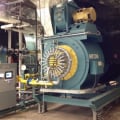Welcome! Here are the website rules, as well as some tips for using this forum.
Need to contact us? Visit https://heatinghelp.com/contact-us/.
Click here to Find a Contractor in your area.
If our community has helped you, please consider making a contribution to support this website. Thanks!
Lost Art Of Heating Revisited Question
Options
Pipestretcher
Member Posts: 6
Hello All,
In "The Lost Art of Steam Heating Revisited" on Page 81. There is a suggestion:
"If you have to submerge a tankless coil in the summertime, do it by hand."
I'm confused. How do I submerge a tankless coil by hand. In my "fixed mindset" I picture only one location for a tankless coil. I might have this mixed with an indirect.
Thanks for any help.
In "The Lost Art of Steam Heating Revisited" on Page 81. There is a suggestion:
"If you have to submerge a tankless coil in the summertime, do it by hand."
I'm confused. How do I submerge a tankless coil by hand. In my "fixed mindset" I picture only one location for a tankless coil. I might have this mixed with an indirect.
Thanks for any help.
0
Comments
-
I believe it means to manually fill the boiler until the coil is fully submerged in the water. Rather than setting the LWCO / feeder high enough to cover it all the time, leading to a water level that is too high in the boiler for producing quality steam.Never stop learning.0
-
So that makes sense.
Earlier in this section there was mention of raising the LWCO, which raised the water line and that caused occupant displeasure: No heat (due to reduced header to water line distance), and water hammer.
So does that mean that raising the water line in the summer to cover the coil will cause water hammer? (No heat will be a desire). Or is the water line height change minimal. It seemed as though the height was needed in the example herein? (All this is very helpful by the way - for reader)
Thanks0 -
I don’t deal with residential work too often, I do mainly commercial. I’ve had to do this with commercial boilers in the past. They would have a second control on them called an aquastat, which senses temperature rather than pressure, and a switch that adds the aquastat into the control circuit. They would manually fill the boiler until the coil was submerged, and the Aquastat would cycle the boiler on temperature rather than steam pressure (so it would never be making steam).
I’m not sure what other way there would be to do it unless you have a valve in the outlet piping from the boiler. If so you could isolate the boiler and let it run on steam pressure. If you can’t isolate the boiler then I’d imagine it would indeed lead to hammering and send out heat in the summer which wouldn’t be good. I don’t have experience with residential though so I’m not sure how it’s typically done.Never stop learning.0 -
Yes, what Mike said. Thanks.Retired and loving it.0
Categories
- All Categories
- 87.3K THE MAIN WALL
- 3.2K A-C, Heat Pumps & Refrigeration
- 61 Biomass
- 429 Carbon Monoxide Awareness
- 120 Chimneys & Flues
- 2.1K Domestic Hot Water
- 5.8K Gas Heating
- 115 Geothermal
- 166 Indoor-Air Quality
- 3.7K Oil Heating
- 77 Pipe Deterioration
- 1K Plumbing
- 6.5K Radiant Heating
- 395 Solar
- 15.7K Strictly Steam
- 3.4K Thermostats and Controls
- 56 Water Quality
- 51 Industry Classes
- 50 Job Opportunities
- 18 Recall Announcements

